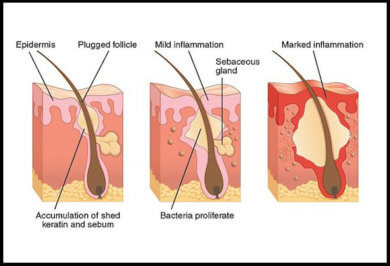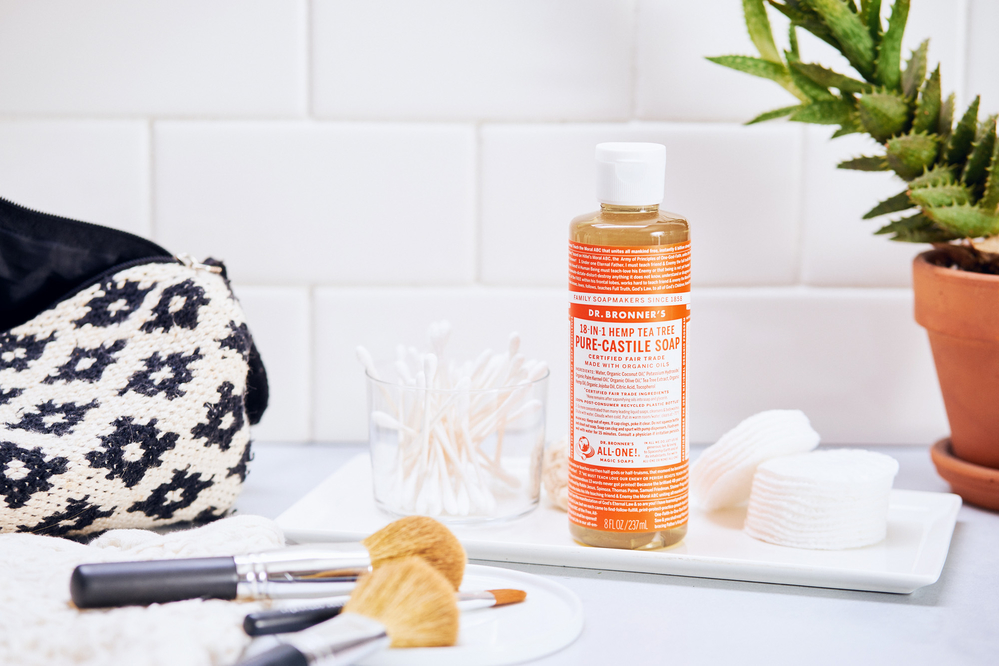Will Dr. Bronner’s help clear my skin?
For anyone who suffers from acne a common question is: will this product or skincare regimen help me? I wish I could say with certainty that Dr. Bronner’s will help you—and although we have seen and received literally hundreds of testimonials from people saying that Dr. Bronner’s has helped them with their acne, we are also aware that it doesn’t work for everyone.
If you’re reading this article then you probably know that acne has a number of underlying causes—that the proper way to treat acne is still a matter of debate within the dermatological and skincare communities, and that there is not one single treatment that works for everyone. That said, Dr. Bronner’s does seem to help a great many people and should be considered as part of a successful skincare regimen for acne-prone skin. To understand why Dr. Bronner’s can help, it will be helpful to first understand the mechanisms that lead to acne breakouts.
What causes acne?
For a good (animated) explainer on the skin science behind acne (acne vulgaris) you can check out this video. Though the exact cause of acne is not completely understood, it is known to primarily result from the blockage and inflammation of pores (also known as hair follicles). This blockage and inflammation can be caused by keratin plugs, sebum and bacterial overgrowth—and often all three of these are present in a breakout.
Keratin plugs occur when an excess of dead skin cells (keratinocytes) and skin proteins (especially keratin) are deposited in the hair follicle, causing either a partial or complete blockage. In addition, sebum, an oily or waxy substance that serves to lubricate and waterproof the skin, can be overproduced by the sebaceous glands, and also create a blockage in the hair follicle. If the pore is completely blocked, it can cause the problem to worsen: bacteria that normally live on the skin and are part of healthy skin functioning become trapped inside the pore and feed on the keratin plug and excess sebum, leading to bacterial overgrowth. The bacterial overgrowth attracts immune cells which then begin attacking the bacteria, resulting in white pus and red inflammation (I know… gross and fascinating!).
 Although there are many subtypes of acne—blackheads, whiteheads, pustules and cysts (often called pimples)—they all result from some combination of keratin plugs, excess sebum and bacterial overgrowth. In a sense, all of the precursors of an acne breakout are part of healthy skin functioning—but an imbalance or excess of these elements can create conditions that can trigger an acne breakout.
Although there are many subtypes of acne—blackheads, whiteheads, pustules and cysts (often called pimples)—they all result from some combination of keratin plugs, excess sebum and bacterial overgrowth. In a sense, all of the precursors of an acne breakout are part of healthy skin functioning—but an imbalance or excess of these elements can create conditions that can trigger an acne breakout.
But what are the underlying causes that can lead our bodies to create excess keratin or excess sebum? This is the bit that is least understood, but dermatologists have honed in on a few genetic and environmental factors that can lead to these imbalances. They include genetic factors that make some people prone to overproduction of keratins, hormonal changes and fluctuations that cause some people to overproduce sebum, and certain cosmetic products which create physical blockages on your pores. Determining and addressing these underlying causes can often be difficult. However there is a lot that can be done to treat the surface symptoms and help manage breakouts—and that is where Dr. Bronner’s soaps come in!
Simple skincare steps for acne-prone skin
Now that we know some of the science behind acne breakouts, we are well-prepared to create a skincare routine that works to address these issues. The routine we are recommending involves three basic steps:
1. Cleanse (with Dr. Bronner’s Pure-Castile Soap)
2. Tone (with Witch Hazel or other alcohol-free, natural toner)
3. Moisturize (with your preferred moisturizer)
Essentially what you are trying to do with this routine is to make sure that you are removing the excess keratin and sebum (as well as any makeup) that could be causing your pores to get blocked up. At the same time, with toning and moisturizing you are trying to make sure that your pores are closed and that your skin doesn’t continue to create excess keratin and sebum. Let’s go through each of these steps in more detail.
Cleansing with Dr. Bronner’s Pure-Castile Soap
As Lisa Bronner discusses in one of her earliest blog posts, washing your face with Dr. Bronner’s Pure-Castile Soap works very well, whether you have acne-prone skin or not. However, certain qualities make it an especially effective cleanser for acne-prone skin. For one, Dr. Bronner’s is a true soap, made up entirely of saponified vegetable oils—no synthetic surfactants that can potentially irritate the skin. Additionally it is a strong cleanser, with no fillers or additives—meaning that it will really clean out your pores and do the important work of removing keratin plugs and makeup. The soap is particularly good at removing oily excess sebum, because of the way a true soap fully surrounds oil molecules so that they can then be rinsed off with water.
Which scent?
The answer largely depends on your skin type and preference—which scent of soap works best for you may involve a bit of trial an error. We recommend that you first try using the Baby Unscented Pure-Castile Soap, which is the best soap for people with sensitive skin and contains no added essential oils. If your skin is already experiencing inflammation, then essential oils can potentially further irritate and inflame your skin.
That said, some people with acne-prone skin seem to have success with the Tea Tree Oil scent—the tea tree extract has antimicrobial properties that can help manage bacterial overgrowth. Finally, people with oilier skin often gravitate to the Peppermint variety, which is slightly more drying than the Baby Unscented or Tea Tree, but leaves your pores feeling completely clean.

Frequency, dilution, and whether to use a brush
Finding the right frequency for cleansing with Dr. Bronner’s Pure-Castile Soap may involve some trial and error. A routine that seems to work for many with acne-prone skin is cleansing every other day— though you may find success with a once- or twice-a-day routine.
The every other day routine is one recommended by both acne vlogger Cassandra Bankson in this video and by Karina Banuelos in this video (Karina’s tweet of “before and after” pics on twitter went viral and garnered her a lot of attention for her routine that included cleansing with Dr. Bronner’s). On the days in-between cleansing with Dr. Bronner’s Pure-Castile Soap you can wash your face with a mild bar soap (like Dr. Bronner’s Pure-Castile bar soap) or skip the cleansing step altogether. Some people find success when they dilute the soap. If you choose to dilute, then dilute the soap by half to start and adjust the strength as needed.
The idea behind using a spin brush for the cleansing step is that you are using the brush’s mechanical action (together with the soap) to scrub your pores clean of anything that might be clogging them. Though this makes sense in theory, it might cause irritation and inflammation if you have sensitive skin. We have seen success stories both with a spin brush and without, so you might try without it first and see if that works. Definitely do not use a spin brush if it causes irritation.
The toning step
The main purpose of the toning step is to tighten up (or close) your thoroughly cleansed and opened pores so that there is less space for keratin plugs and sebum to be redeposited in the pores. Look for ingredients like witch hazel extract, aloe vera, or green tea extract—which all have astringent qualities. An astringent toner will cause cell tissues to contract and will help pores close up, which is what you want at this stage. Avoid any toner that contains alcohol or synthetic ingredients.
The moisturizing step
Depending on your skin type and the exact scent of soap you use, you may find that your skin is on the dry side after washing with Dr. Bronner’s Pure-Castile Soap. Dry skin is not only uncomfortable, but can cause your skin to respond to the dryness by producing additional sebum—after all sebum is your skin’s own moisturizer. However, since overproduction of sebum is one of the issues we’re trying to avoid, it is best not to trigger this response in your skin.
Which moisturizer should you use? Some people with acne-prone skin find that simply using pure jojoba oil as a moisturizer works well—which makes sense as jojoba oil is prized for being non-comedogenic and for mimicking the skin’s own oils.
We have seen testimonials for our Organic Lotions and Organic Coconut Oil as moisturizers, but they may not work for everyone that has acne-prone skin. Do Dr. Bronner’s lotions or coconut oil work for you? Let us know!
But what about the soaps’s pH?
There has been a lot of online fretting and fussing about the skin’s natural pH and the need to find products that do not disturb the skin’s natural acidity. Lisa Bronner will be posting a blog post on this topic in the next few weeks, but for now, suffice it to say that this issue has been highly misunderstood and overblown. Briefly put: the acid mantle that covers the skin and gives your skin its slight acidity is not affected by soap. The soap may briefly wash off the elements that make up the mantle, but your skin simply secretes them again and the mantle reforms very quickly.
Dr. Bronner’s soaps and lotions have coconut oil—isn’t coconut oil comedogenic?
When it comes to our soaps, you can be sure that they are non-comedogenic. It is important to understand that the coconut oil in our soaps is “saponified.” Meaning it is no longer an oil—it has been turned into a soap molecule by combining it with potassium hydroxide (potash). On our U.S. labels we are required to show the ingredients as they are prior to this reaction, which is why you see “coconut oil” listed as an ingredient (in other countries, where labeling regulations are different, this ingredient is often listed as “saponified coconut oil”).
But that still leaves the question of whether coconut oil on its own (and in our lotions) is comedogenic. The short answer is we don’t know, and there is not enough research on the topic. The comedogenic scale by which ingredients are rated is a flawed and unreliable measure, as laid out in this blog post, and coconut oil has anti-bacterial properties, which may make it beneficial for acne-prone skin. At the end of they day, you will have to use your own experience to determine if coconut oil is an ingredient that helps or hurts your acne.
Tell us about your experience!
Have you used Dr. Bronner’s to treat your acne? We’d love to hear if it helped and what your exact routine is. Leave us a comment below!

Rafi Loiederman is Content Editor at Dr. Bronner’s, and has been using the company’s products for over 20 years. He enjoys recording and performing music, is an avid hiker and naturalist, and an erstwhile linguist.